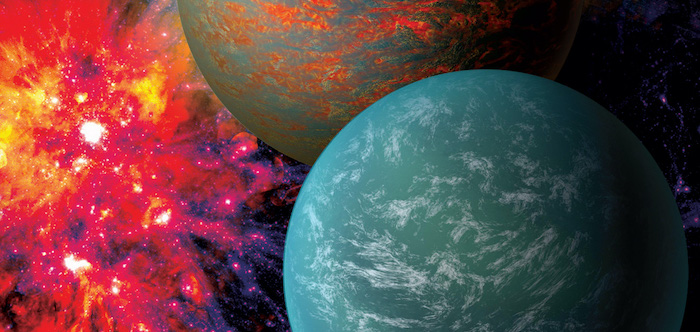KU astronomers help point the way forward for America's research priorities

LAWRENCE — When the James Webb Space Telescope is blasted into orbit in December, it will be partly due to groups of astronomers and astrophysicists, organized by the National Academies of Sciences, who decided years ago that creating a next-generation space telescope should be a U.S. national priority.
Each decade, in fact, prominent scientists convene and produce a kind of research roadmap for astronomy and astrophysics under the sponsorship of NAS. The “decadal survey” is meant to make sure the United States stays at the forefront of astronomy and astrophysics.
Two scientists from the University of Kansas — Ian Crossfield, assistant professor of physics & astronomy, and David Besson, professor of physics & astronomy — contributed to the Decadal Survey on Astronomy and Astrophysics 2020, published in November.
“The decadal survey process is how the American astronomical community identifies its top science priorities for the next decade,” Crossfield said. “The report that was produced by this committee, including me and David, is the main reference document that’s used by congressional staffers, NASA and the NSF to set top funding priorities for what needs to happen over the next 10 years.”
Besson added that aside from setting research goals on the ground and in space, other objectives of the decadal survey include keeping the American public engaged with astronomy and astrophysics and assessing and developing the workforce in these disciplines.
“The decadal survey keeps America on pace with Europe and, ultimately, that also means trying to sustain and develop the next generation of scientists in the country,” he said. “You want to keep America a country that believes in science and is interested in science, which is not a small statement.”
Scientists working on the survey were organized into several sub-panels covering different aspects of astronomy and astrophysics.
Besson, whose research centers on detection and observation of neutrinos, served on the Panel on Particle Astrophysics and Gravitation. According to the report, the panel’s purpose was to “suggest to the decadal survey committee a program of federal investment in research activities exploring areas at the interface of physics and astronomy such as gravitational radiation, gamma-ray astronomy, cosmic rays and neutrinos.”
Besson said his participation in the survey helped him to fit his own research into a broader perspective.
“For me it was certainly a learning experience,” he said. “I was impressed by the breadth of the big-picture understanding of the people leading the panel. It was also interesting for me to see the experiment that I’m on, called IceCube, in the context of all these other experiments because I rarely put it in that broad context.”
Crossfield, who leads the KU ExoLab, a research group dedicated to the discovery and characterization of nearby planetary systems, served on the Panel on Exoplanets, Astrobiology, and the Solar System. The panel focused on “the detection, demographics and physical characteristics of exoplanets, solar system observations relevant to Astro2020, astrobiology, stellar phenomena and activity that impacts detectability and characterization of exoplanets, and effects of stellar activity on the evolution and habitability of planets,” according to the survey report.
“Our science panels focused on top-priority science questions that need to be answered in the next decade,” Crossfield said. “There’s also a series of technological or observatory driven panels focused on things like cost estimates and technical capabilities. Then, there’s the overarching executive panel that synthesizes these reports, makes the final recommendations, puts the bow on it and sends it out to the national academies and to the country.”
The KU researchers said key recommendations of the decadal survey include “a large-scale next-generation Hubble Space Telescope that would be two or three times as big as Hubble” and “ground-based telescopes operating in the optical and infrared that would also be two to three times bigger than anything else currently operating.”
According to Besson, another key facet of the decadal survey’s work was to promote a diverse workforce in American astronomy and astrophysics.
“I was impressed by the appreciation of the fact that science is done within a society and there is a responsibility to be more inclusive in the scientific community as a whole,” he said. “This was certainly touched on in our sub-panel report and in the final report as well.”
Crossfield said the presence of two scientists from KU reflected the mounting strength of the Department of Physics & Astronomy.
“If you dig through the membership numbers of who is participating in different panels of the decadal process this time around, the fact that there were two KU faculty in this process puts KU astrophysics in the top two dozen universities in the country in this field,” he said. “That’s a really big statement about the positive trajectory that KU astronomy and astrophysics has been on over the last few years.”
Photo: Each decade, prominent scientists convene and produce a kind of research roadmap for astronomy and astrophysics under the sponsorship of the National Academies of Sciences. The “decadal survey” is meant to make sure the United States stays at the forefront of astronomy and astrophysics. CREDIT: National Academies of Sciences.